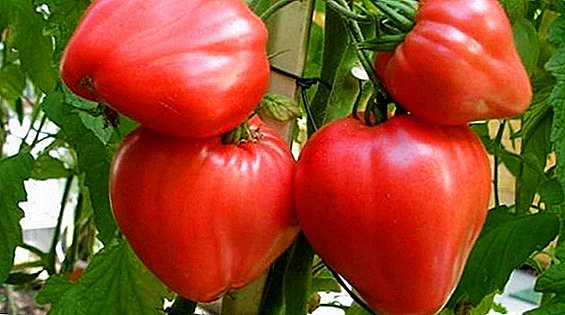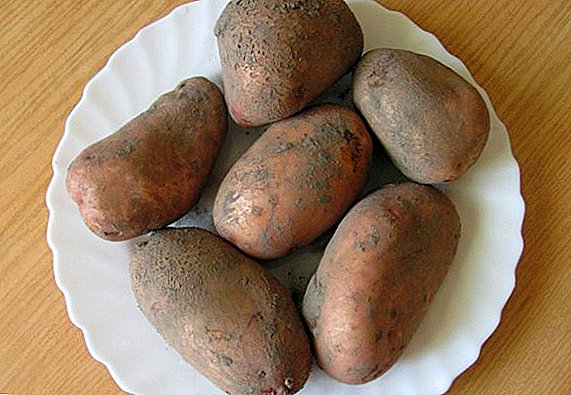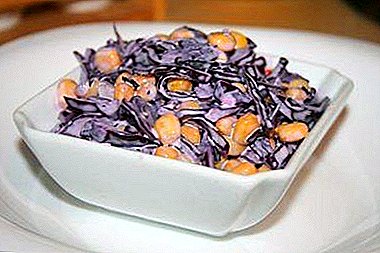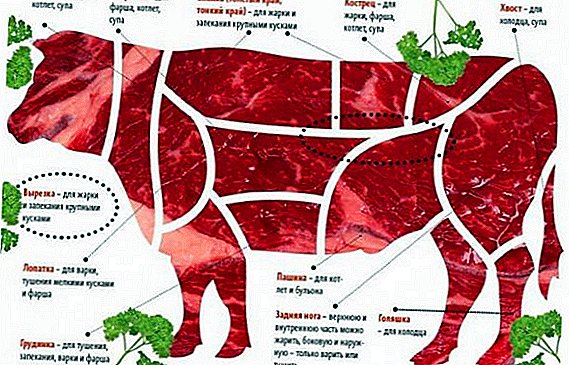 In the modern world, disputes about the appropriateness and rationality of introducing meat into the human diet are frequent. From a vegetarian point of view, it would be much more humane to abandon it, but in practice humanity is not yet ready for this.
In the modern world, disputes about the appropriateness and rationality of introducing meat into the human diet are frequent. From a vegetarian point of view, it would be much more humane to abandon it, but in practice humanity is not yet ready for this.
In its defense, meat eaters cite more and more new arguments for its indispensability, and beef is invariably among the most sought-after options for such food in our country. Why it is so valuable and what impact on our body can have - read on.
Why bull meat and cows are called beef
The modern concept of "beef" appeared in the days of Russia, when cattle were often called "beef", that is, "bull" or "cattle." At the same time, this term has the root "gou", because of which it is very consonant with such words as the Indo-European "govs", the English "cow" and the Armenian "kov". Translated, all these words mean "cow."  At the same time, in the explanatory dictionary of Dahl there is a clarification regarding the bull, which literally makes beef "meat taken from the bull." The logic in this statement is present, because our ancestors slaughtered cows only as a last resort, using them mainly as a source of milk. The role of the meat source more suited large and strong bulls.
At the same time, in the explanatory dictionary of Dahl there is a clarification regarding the bull, which literally makes beef "meat taken from the bull." The logic in this statement is present, because our ancestors slaughtered cows only as a last resort, using them mainly as a source of milk. The role of the meat source more suited large and strong bulls.
Depending on the age of the killed animal, today there are other concepts that characterize their meat:
- milk veal - meat of 2-3 weeks old calves;
- young beef - 3 months - 3 years;
- beef - meat from an animal older than three years.
Did you know? Cows have a very well developed sense of time, so if the milkmaid is at least half an hour late, the milk yield will be reduced by 5%, and the fat content of the milk will fall by 0.2-0.4%.
Calorie and chemical composition
Calorie and chemical composition of beef depends on the category of meat. So for products of the first category are fair the following values (per 100 g):
- proteins - 18.6 g;
- fats - 15.9 g;
- carbohydrates - 0 g;
- water - 64.4 g;
- ash - 0.9 g;
- cholesterol - 0.08 g;
- Omega-3 acids - 0.1 g;
- Omega-6 acid - 0.4 g
 Beef second category (with underdeveloped muscle tissue and a small amount of fat deposited in the kidney, pelvic and thigh areas) is characterized by the following indicators:
Beef second category (with underdeveloped muscle tissue and a small amount of fat deposited in the kidney, pelvic and thigh areas) is characterized by the following indicators:
- proteins - 19.9 g;
- fats - 9.7 g;
- carbohydrates - 0 g;
- water - 69 g;
- ash - 1 g;
- cholesterol - 0.07 g;
- Omega-3 acids - 0.1 g;
- Omega-6 acid - 0.3 g
In this case, the caloric content of the lean product will be 156 kcal, the same amount of marble meat gives 170 kcal, and in the stewed variety, this figure rises to 232 kcal. On average, there are 187 kcal per 100 g of beef.
Among of vitaminsIncluded and extremely beneficial to humans, it is possible to isolate vitamins of group B (B1, B2, B5, B6, B9, B12), as well as E, H, C, PP. In addition to them go and no less useful. micro and macronutrientsrepresented by iodine, fluorine, copper, nickel, chromium, molybdenum, zinc, and also chlorine, magnesium, potassium, phosphorus, calcium, sulfur, sodium.
Read also about the composition, properties and use of poultry meat (chicken, quail, duck, goose, guinea fowl, turkey, pheasant, peacock, ostrich), as well as a rabbit and a sheep.
What are the benefits for the body
Female, male and especially children's organisms need different amounts of micro and macro elements, so even the most useful products can affect their well-being in different ways. Let's find out what is the use of beef, and whether it should be used at all different categories of people. 
Men
Our grandmothers also argued that for physical strength a man just needs to eat meat, because it is his body that provides energy for a long time. Considering that beef contains very little fat, it can be considered as a good ingredient in various dishes of athletes and simply those who want to always stay in shape.
True, there are some limitations in the use of this product. Depending on the age of the representative of the stronger sex, the daily rate of consumption of such meat ranges from 170-180 g (the older the man, the less beef he relies).
Important! Do not forget that cow meat contains cholesterol, so in order not to increase it in the process of frying, it is advisable to cook boiled or stewed dishes with the participation of this ingredient.
Women
As for men, female beef will be useful for a variety of diets and simply as an alternative to more fatty types of meat products. Vitamin B5 in its composition contributes to all metabolic processes in the human body, which means that the breakdown of fats will occur faster.  Vitamin B2 has a positive effect on the condition of the skin, and vitamin C helps to strengthen the vascular walls and, together with vitamin E, increases the protective functions of the body, thereby helping to prevent the development of varicose veins and colds. Depending on the age, the rate of beef consumed by a woman per day will also be different: at a younger age her number can reach 160 g, and after 30 years it is desirable to reduce this number to 140 g.
Vitamin B2 has a positive effect on the condition of the skin, and vitamin C helps to strengthen the vascular walls and, together with vitamin E, increases the protective functions of the body, thereby helping to prevent the development of varicose veins and colds. Depending on the age, the rate of beef consumed by a woman per day will also be different: at a younger age her number can reach 160 g, and after 30 years it is desirable to reduce this number to 140 g.
Learn more about cow's milk: fat, density, composition, benefits and harms, processing methods and types.
Children
The easiest way to use the beef can be traced to the children's body, as it is constantly growing and developing. In this case positive changes under the influence of such meat are expressed in the following:
- The proteins present in the product are absorbed easier than from other types of meat, and this is the main building material for growing tissues of all organs. Elastin and collagen (varieties of beef protein) guarantee the strength and elasticity of connective tissue and skin, the improvement of which is also observed due to the activity of vitamin B2.
- Vitamin B6 provides the normal functioning of the central nervous system, conducting nerve impulses, stimulation of the reactions of excitation and inhibition.
- B12 takes part in blood-forming processes and, like iron, prevents the development of anemia, which is especially relevant in childhood. In addition, this component of beef contributes to the active development of muscle tissue.
- Phosphorus helps to maintain the acid-base balance in the body and together with calcium strengthens the bones and teeth of the child. The lack of these elements may well provoke the development of rickets in the baby.
- Potassium and sodium support water and electrolyte balance, optimize the heart and normalize its rhythm.
- Vitamin PP helps to convert nutrients into energy, improves digestive processes.
- Copper significantly increases the body's absorption of proteins and iron, and also contributes to the delivery of oxygen to the cells of tissues.
- Ascorbic acid enhances the immunity of the child, helping to cope with viral infections.
 In addition, the vitamin-mineral complex contained in cattle meat, accelerates the regenerative processes and accelerates the healing of wound surfaces, and injuries in childhood are very common.
In addition, the vitamin-mineral complex contained in cattle meat, accelerates the regenerative processes and accelerates the healing of wound surfaces, and injuries in childhood are very common.
Did you know? In the first year of their life, children gain about 25 cm in height, then, in the second year of life, the baby grows another 8-12 cm, and then annually adds 4-6 cm in height.
What could be the harm
With all its beneficial properties, beef can cause some harm to the human body. Of course, if you use meat infrequently and follow all the rules of its preparation, then there is nothing to be afraid of, but, in any case, you should know about possible troubles, which include the following:
- the accumulation of cholesterol in the body due to excessive consumption of beef, which, in turn, may adversely affect the state of the gastrointestinal tract and the cardiovascular system;
- The purine bases which are a part of a product, at the unlimited use cause accumulation of uric acid, thereby increasing risk of development of an osteochondrosis, an urolithiasis and gout;
- frequent consumption of meat also increases the number of putrefactive bacteria in the colon, as a result of the development of which skatol, cresol, phenol, cadaverine, indole and other similar substances appear that can not only poison the intestines, but also, being absorbed into the blood, cause damage to internal organs.
Important! Roast beef brings particular harm, since a certain amount of this component from the overdried vegetable oil is also added to the cholesterol it contains.To prevent the development of all these unpleasant consequences, you should always observe the rate of use of the described product:
- for women under 30 years old - no more than 157 g per day, and after 31 years - about 142 g;
- for men under 30 years old - no more than 185 g per day, and after 31 years - about 171 g.
Moreover, doctors do not advise eating more than 550 g of beef a week, which will save you from atherosclerosis, gout, urolithiasis, osteochondrosis and other unpleasant manifestations in the body.
Pieces of cow meat
Practically all parts of a cow are eaten by man, only their benefits (as well as their cost) will be different. This difference is due to the beef variety: from top quality to second-class. According to the varietal variation, the carcass is divided into parts. 
Top grade
The highest grade includes the most delicious, nutritious and healthy meat obtained from the dorsal and thoracic parts, as well as some other areas of the cow's body. Particularly appreciated are sirloin, sirloin sirloin (or rump), thigh (rump), upper part of the back thigh (rump). Each of them is suitable for preparing "his" dish, so when choosing meat it is advisable to understand the features of each piece.
Back part
The dorsal part, which can be further divided into a thick edge (it is often called a "filet"), ribs on ribs, entrecotes and ribs, can be used to prepare first and second courses, as well as to bake in an oven in large chunks. This is the most delicious and juicy meat, so it is valued much higher than the other parts. 
Chest part
Brisket is a part from the front quarter of the carcass, which forms the chest. This is a good combination of meat, fat and bones. Conventionally, it can be divided into the anterior, middle, core of the brisket and the brisket itself. The first has almost no bones, but rather fat, thanks to which it is successfully used to make broth (it is desirable to remove the fat in advance).  The most valuable of this list is precisely the core, consisting of the brisket, meat and fatty layer. The average brisket has some bones and is considered the leanest part, but it is quite nutritious and can be used both for cooking soup and for roast.
The most valuable of this list is precisely the core, consisting of the brisket, meat and fatty layer. The average brisket has some bones and is considered the leanest part, but it is quite nutritious and can be used both for cooking soup and for roast.
The whole sternum or only a separate part of it can be separated from the bone, stuffed and boiled in the form of a roll. You can simply chop the meat into pieces for stewing or boiling.
Sirloin
Beef carcass loin is more expensive than all the rest. It belongs to the dorsal zone and is a lumbar part (thin edge), with very tender and lean meat, ideal for cooking steaks, roast beef, azu, goulash, chop patties and rolls. It is possible to attribute to the sirloin not only a thin edge, but also sirloin on a bone, sirloin without a bone and tenderloin. Chateaubriand is obtained from the middle of the fileka, tournedo from the thinnest part, and filet mignon from the sharp end. 
Rump
Rump is called the part of the carcass, located near the pelvis. It is usually characterized by thin fatty layers and has a loose fiber structure. Great for stewing and frying. 
Kostrets
It is located in the upper part of the back of the thigh and is most often used for roasting in the oven in a large piece or for making escalopes, medallions, chops and chopped cutlets. In addition, the rump can be cooked on an open fire, which only expands the culinary possibilities. 
Rump
This part is cut into several pieces, along the lines of contact of the three main femoral muscles: the incision, the probe, and the thick edge of the flank. The probe is a meat with fine fibers, obtained from the inner thigh. It is very gentle and only slightly surpasses the thick flank. Ssekom called the outer zone of the mid-femoral part of the carcass. Its muscle fibers are slightly thicker and rougher, with tufts surrounded by more developed tissue. Such meat is perfect for stewing or cooking in the oven.
Important! All the above-described parts from the “top grade” group have one thing in common - they contain the least amount of poorly stable collagen, so this product is ideal for roasting.
First grade
Unlike the premium, the first is much more often used for stewing and processing for minced meat, but this does not mean that the quality of such meat is at a low level. This group includes the scapular and humeral parts, the flank and the neck.
Scapular
Spatula - meat with relatively coarse fibers and thick veins, but lean. From it you can cook the first dishes, as well as additions to the side dishes in the form of stewed culinary products, steaks, goulash, azu, minced meatballs and meat rolls. Sometimes the shoulder part is found on sale under the name "meat for frying from the front quarter". 
Shoulder
According to taste characteristics, the shoulder section can be compared to a thigh or a rump, since meat is characterized by delicate fibers and is suitable for cooking fried meat, minced meatballs, filling soups and clear broths. If desired, from it you can fry or bake rolls. 
Pashina
Such meat has a coarse texture, but it has a good taste. It can be used for grinding, followed by the preparation of meatballs, cuts, rolls, first courses (soups and borscht), as well as zraz. Bones and cartilages can be found in the plow, which, depending on the method of preparation, are removed or simply crushed. Pure meat is sometimes rolled up and stuffed, making a roll out of it. It is suitable for cooking chopped veal. 
Second grade
The second type of meat is relatively cheaper than the previous ones, but even good food can be made from such products. Both the neck, and the front and back shanks can be used for stewing, boiling and even frying in slices, although this process sometimes takes longer than when cooking meat of the highest or first grade.
Nose (neck)
It is represented by muscle tissue and contains a fairly large number of tendons, but, in general, it has good taste. Suitable for prolonged boiling and stewing, cooking filling soups, broths, minced meat for chops, goulash and even brawn, but it is advisable to immediately remove all existing tendons. In addition, a good stew or a strong broth for filling the first courses will turn out from the neck, but before using it you have to boil the meat for a long time (long-term exposure to high temperatures is necessary). The neck from the back of the head has a good layer of fat, thanks to which, when baking, you get a very juicy and tasty roast. It is possible to use this part for the preparation of minced meat or pickling in small pieces. 
Front shank (knuckle)
It is characterized by a large number of connective tissue and tendons, because of which the knuckle is much harder than the previous parts of the beef. In addition, this part contains the brain bone and gelatin, which will be very appropriate in the preparation of broth and jelly. From the soft part, you can make cues, meatballs, rolls and stews, but only after removing all the tendons. 
Rear shank
The detachment of the posterior shank is performed across the tibia, at a level slightly lower than 1/3 of its part (the Achilles tendon is separated in advance at the place of its transition into muscle tissue). As well as the front shank, the back often goes on sale sliced (approximately 4-5 cm thick), which require prolonged heat treatment. It is used for the same purposes as the front shank, but it is the jelly that is especially tasty.
Did you know? The history of brawn began several thousand years ago, when the nomadic peoples of the North noticed the property of rich broth to freeze in the cold. Later, this dish was an excellent addition to the campaign, allowing you to quickly saturate the merchants, warriors and hunters. In the days of Russia, it was cooked after a lush feast, pouring all the remnants from the table with a liquid. Such food was meant for the servant.
How to choose when buying
Even the highest quality beef can not meet your expectations, if you do not know how to choose it correctly. Deciding exactly what part you need and going after it to the store or to the market, remember the basic rules of choice:
- fresh meat of a young animal must be bright red, without any dots and spots (dark shades will indicate that the piece was obtained from the carcass of an old animal);
- the existing fat layer should always be dense, with crumbling structure and white color;
- the surface of the fresh meat piece will always be elastic and dry, returning its shape when pressed with a finger;
- никакого неприятного запаха от свежей тушки исходить не должно, а если вы покупаете замороженный продукт, проследите, чтобы на упаковке не было снега или большого скопления льдинок, так как такие кристаллы появляются именно при нарушении правил хранения или при повторной заморозке уже размороженного продукта.
 Remember that the best soups, broths and other first courses are made from rump, rump with bone, shoulder blade, shoulder, rump, or the front of the chest area. For cooking roasts, it is advisable to choose a tenderloin, sirloin, rump and rump, and to create chops, meatballs, meatballs and various meat fillings, it is better to purchase a shoulder, a bottom rump, meat from shank and flank. And for delicious kholodets (jellies) it is worth finding the right knuckles, drumsticks and tail.
Remember that the best soups, broths and other first courses are made from rump, rump with bone, shoulder blade, shoulder, rump, or the front of the chest area. For cooking roasts, it is advisable to choose a tenderloin, sirloin, rump and rump, and to create chops, meatballs, meatballs and various meat fillings, it is better to purchase a shoulder, a bottom rump, meat from shank and flank. And for delicious kholodets (jellies) it is worth finding the right knuckles, drumsticks and tail.Video: Beef Tips
How to store at home
Fresh beef meat can be stored in the refrigerator not more than three days in a row, but in the freezer this period is increased to 10 days. In addition, when stored in the freezer, the useful and taste properties of the product will be preserved much better than when stored in the refrigerator. It is possible to prolong the shelf life in the latter with the help of marinade, but it will not be possible to use such meat for all dishes.  In general, beef is a tasty and healthy product, but you should not consider it too harmless. Get the maximum benefit for the body and avoid possible negative consequences can only be subject to the rules of choice, cooking and metered consumption of meat.
In general, beef is a tasty and healthy product, but you should not consider it too harmless. Get the maximum benefit for the body and avoid possible negative consequences can only be subject to the rules of choice, cooking and metered consumption of meat.












